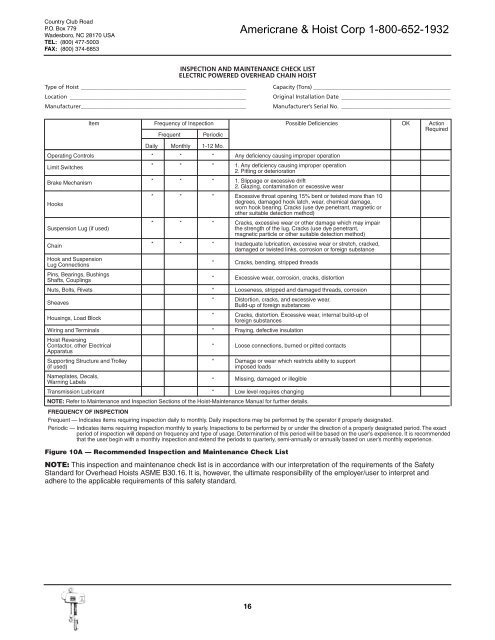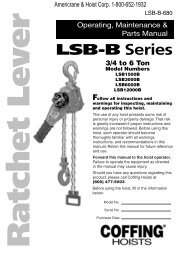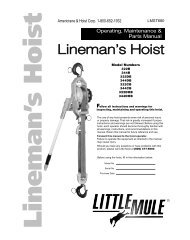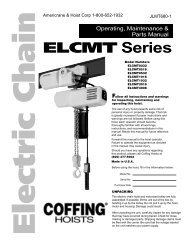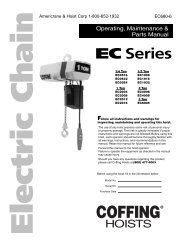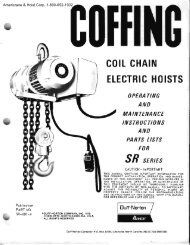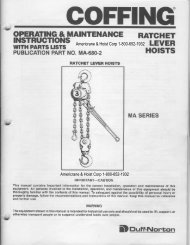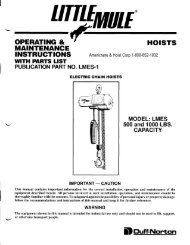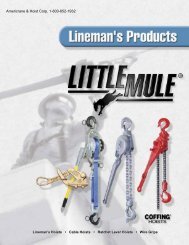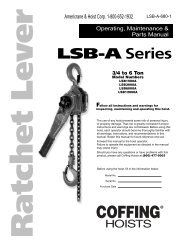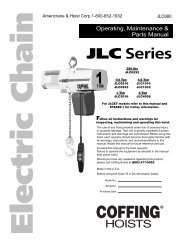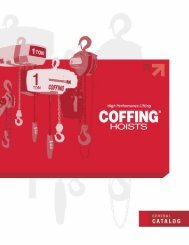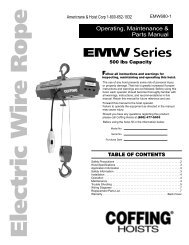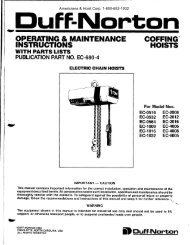ELC Series, JL 680-2 - Coffing Hoists, Coffing Hoist Parts
ELC Series, JL 680-2 - Coffing Hoists, Coffing Hoist Parts
ELC Series, JL 680-2 - Coffing Hoists, Coffing Hoist Parts
Create successful ePaper yourself
Turn your PDF publications into a flip-book with our unique Google optimized e-Paper software.
Country Club Road<br />
P.O. Box 779<br />
Wadesboro, NC 28170 USA<br />
TEL: (800) 477-5003<br />
FAX: (800) 374-6853<br />
INSPECTION AND MAINTENANCE CHECK LIST<br />
ELECTRIC POWERED OVERHEAD CHAIN HOIST<br />
Type of <strong>Hoist</strong> ___________________________________________________________<br />
Location _______________________________________________________________<br />
Manufacturer___________________________________________________________<br />
Capacity (Tons) _________________________________________________<br />
Original Installation Date _______________________________________<br />
Manufacturer’s Serial No. _______________________________________<br />
Item Frequency of Inspection Possible Deficiencies OK Action<br />
Required<br />
Frequent Periodic<br />
Daily Monthly 1-12 Mo.<br />
Operating Controls * * * Any deficiency causing improper operation<br />
Limit Switches * * * 1. Any deficiency causing improper operation<br />
2. Pitting or deterioration<br />
Brake Mechanism * * * 1. Slippage or excessive drift<br />
2. Glazing, contamination or excessive wear<br />
Hooks<br />
* * * Excessive throat opening 15% bent or twisted more than 10<br />
degrees, damaged hook latch, wear, chemical damage,<br />
worn hook bearing. Cracks (use dye penetrant, magnetic or<br />
other suitable detection method)<br />
* * * Cracks, excessive wear or other damage which may impair<br />
Suspension Lug (if used)<br />
the strength of the lug. Cracks (use dye penetrant,<br />
magnetic particle or other suitable detection method)<br />
Chain * * * Inadequate lubrication, excessive wear or stretch, cracked,<br />
damaged or twisted links, corrosion or foreign substance<br />
Hook and Suspension<br />
Lug Connections<br />
* Cracks, bending, stripped threads<br />
Pins, Bearings, Bushings<br />
Shafts, Couplings<br />
* Excessive wear, corrosion, cracks, distortion<br />
Nuts, Bolts, Rivets * Looseness, stripped and damaged threads, corrosion<br />
Sheaves<br />
Housings, Load Block<br />
* Distortion, cracks, and excessive wear.<br />
Build-up of foreign substances<br />
* Cracks, distortion. Excessive wear, internal build-up of<br />
foreign substances<br />
Wiring and Terminals * Fraying, defective insulation<br />
<strong>Hoist</strong> Reversing<br />
Contactor, other Electrical * Loose connections, burned or pitted contacts<br />
Apparatus<br />
Supporting Structure and Trolley * Damage or wear which restricts ability to support<br />
(if used)<br />
imposed loads<br />
Nameplates, Decals,<br />
Warning Labels<br />
* Missing, damaged or illegible<br />
Transmission Lubricant * Low level requires changing<br />
NOTE: Refer to Maintenance and Inspection Sections of the <strong>Hoist</strong>-Maintenance Manual for further details.<br />
FREQUENCY OF INSPECTION<br />
Frequent — Indicates items requiring inspection daily to monthly. Daily inspections may be performed by the operator if properly designated.<br />
Periodic — Indicates items requiring inspection monthly to yearly. Inspections to be performed by or under the direction of a properly designated period. The exact<br />
period of inspection will depend on frequency and type of usage. Determination of this period will be based on the user’s experience. It is recommended<br />
that the user begin with a monthly inspection and extend the periods to quarterly, semi-annually or annually based on user’s monthly experience.<br />
Figure 10A — Recommended Inspection and Maintenance Check List<br />
NOTE: This inspection and maintenance check list is in accordance with our interpretation of the requirements of the Safety<br />
Standard for Overhead <strong><strong>Hoist</strong>s</strong> ASME B30.16. It is, however, the ultimate responsibility of the employer/user to interpret and<br />
adhere to the applicable requirements of this safety standard.<br />
16


